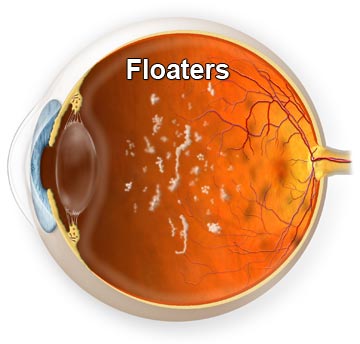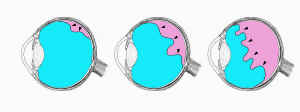
VITREOUS FLOATERS
The phenomenon of vitreous floaters is due to a deterioration of the vitreous body. The vitreous is a gelatinous and initially compact substance that fills up the intraocular space situated between the retina and the crystalline lens. This substance, due to natural aging or other concomitant causes (myopia and others) is during the years bound to lose part of its integrity. The appearance of vitreous floaters is a sign that the vitreous is slightly liquefied and some of its fibres move within the eye. The liquefaction of the vitreous often provokes a vitreal detachment with subsequent proliferation of the mobile bodies and possibly retinal lesions. Because of the continuous movements of the eye, the deteriorated vitreal fibres can also cause the appearance of flashes in the field of view due to the mechanical stimulation of the retina. In these cases, a routine examination of the bottom of the eye is necessary in order to control the integrity of the retina that otherwise, with time, could be perforated
Vitreous Detachment
The vitreous, not to be confused with the crystalline lens, is the gelatine that fills the inside of the eye, in direct contact with the retina: in the drawing below it is coloured in blue. The detachment of the vitreous is represented in three phases, from left to right. For several reasons (heat, sweating, traumas among the most common causes) the vitreous loses its water content and contracts, like a squeezed sponge, progressively detaching from the retina. The patient often sees flashes and mobile bodies within his/her field of view.

Following the vitreal detachment from the retina, or due to the traction exercised by the vitreous on the retina, it can happen that small holes occur in the retina. These, once identified, must be treated with a laser to prevent the future occurrence of the more serious detachment of the retina.
Symptoms
The typical reported symptom is the appearance of objects of varied shape and type fluctuating within the eye. The objects are not fixed but try to “escape” when trying to stare at them.
These mobile bodies appear in a particularly clear way when the affected turns to look towards light and bright surfaces (such as white walls and the blue sky). Although the patient has the feeling of seeing them on the eye surface, in reality these objects are floating inside the vitreous and their perception is due to the projection on the retina (the "photosensitive film" of the eye). The vitreal gel that fills the eyeball sometimes exercises a traction on the retina. This causes the appearance of flashes in absence of a true luminous stimulus An often reported symptom is indeed the appearance of brief luminous flashes when moving the eyes quickly on the horizontal axis in conditions of darkness. The same feeling is experienced when a person compresses the eye and sees "stars".
Tipologies
The types of mobile bodies reported by the patients are several, differing in shape and density. The bodies can occur as rings, lines, cobwebs, points and different combinations of the above, with a density that makes them more or less visible according to the intensity of the light.
The section "What we see" attempts to simulate the field of view of patients affected from vitreous floaters.
COMING SOON...